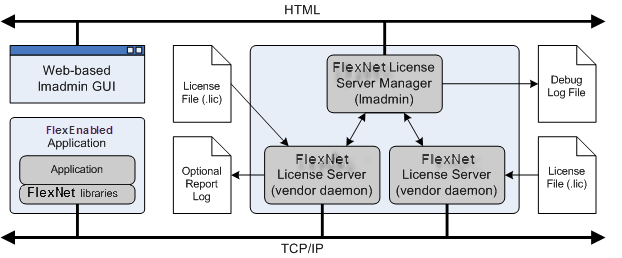Overview of FlexNet Publisher
FlexNet Publisher is a member of the FlexNet family of products. It is the most popular licensing system used in the software industry. FlexNet Publisher is best known for its ability to allow software licenses to be available (or float) anywhere on a network, instead of being tied to specific machines. Floating licensing benefits both users and license administrators. Users make more efficient use of fewer licenses by sharing them on the network. License administrators control who uses the FlexEnabled application and the machines where the licenses are available.
About lmadmin
The lmadmin license server manager supports a client connection over HTTP and provides a Web-based administrative interface.
The lmadmin license server manager is designed to:
|
•
|
Import existing license files. |
|
•
|
Launch without requiring any configuration options. |
|
•
|
Perform all server configuration and most administration functions from the interface. |
|
•
|
Keep configuration options persistent—if you change settings and relaunch the tool, the previously set options stay in effect. |
In addition, the lmadmin license server manager is:
|
•
|
Compatible with license files and vendor daemons produced using FlexNet Publisher 9.2 and later. |
|
•
|
Optimized for an operating model of one lmadmin process with multiple vendor daemons. |
FlexNet Publisher Components
FlexNet Publisher components are organized based on the license model used by your software publisher. License models are classified according to their requirement for a license server system:
|
•
|
Licenses are served by a license server. This is commonly referred to as a served license model. |
|
•
|
Licenses are not served by a license server system but are available directly to the application. This is commonly referred to as an uncounted, or unserved license model. The lmadmin license server manager is not used with unserved (also called node-locked) licenses. |
Served Licenses
For served licenses, there are four required FlexNet Publisher components:
|
•
|
The FlexEnabled application, with the FlexNet Publisher static client library linked into it. |
|
•
|
The license server manager (lmadmin), which handles the initial contact with the FlexEnabled applications, passing the connection on to the appropriate vendor daemon. It also starts and restarts the vendor daemons. |
|
•
|
A vendor daemon, one process for each vendor who has a FlexEnabled product on the network. The vendor daemons keep track of how many licenses are checked out, and who has them. FlexEnabled applications communicate with the vendor daemons through TCP/IP network communications. |
|
•
|
A source for license rights, either a license file (created by the software publisher and installed by the license administrator) or trusted storage (set up using FlexNet Operations, see the License Administration Guide). Either type of source contains information about the server machines and vendor daemons and has at least one entry for each FlexEnabled product, specifying that product’s license details. |
In addition to these four FlexNet Licensing components, there are two optional components:
|
•
|
Debug Log File — Created and written by lmadmin. |
|
•
|
Report Log File — Created and written by the vendor daemon for use by FlexNet Manager. |
The following diagram shows the relationship these FlexNet Publisher components have to one another:

Typically, the license server components reside on a machine in the network, but can optionally reside on the same machine as the FlexEnabled application.
